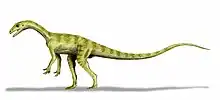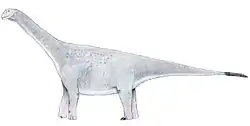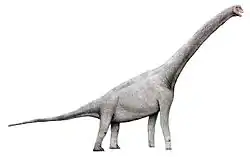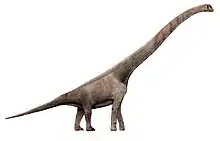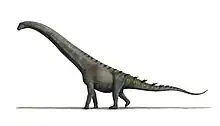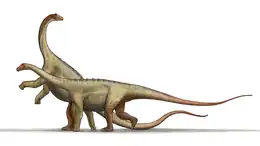Gryponyx
Gryponyx (meaning "hooked-claw") is an extinct genus of massopod sauropodomorph known from southern Free State, central South Africa.[1]
| Gryponyx Temporal range: Lower Jurassic | |
|---|---|
.jpg.webp) | |
| Part of the holotype | |
| Scientific classification | |
| Domain: | Eukaryota |
| Kingdom: | Animalia |
| Phylum: | Chordata |
| Clade: | Dinosauria |
| Clade: | Saurischia |
| Clade: | †Sauropodomorpha |
| Clade: | †Massopoda |
| Family: | †Gryponychidae Huene, 1932 |
| Genus: | †Gryponyx Broom, 1911 |
| Species: | †G. africanus |
| Binomial name | |
| †Gryponyx africanus Broom, 1911 | |
Description
Gryponyx africanus is known from the holotype SAM 3357-59, a nearly complete postcranial skeleton which includes partial vertebral column, pelvis, both forelimbs and both hindlimbs. Gryponyx has been estimated to have been about 5 m (16 ft) in length. It was collected from the Upper Elliot Formation of the Stormberg Group (Karoo Basin), dating to the Hettangian to Sinemurian stages of the Lower Jurassic period.[1]
It was originally described by Broom (1911) as a theropod.[1] Huene (1932) named the family Gryponychidae to contain Gryponyx and Aetonyx and placed it within Carnosauria.[2] Galton and Cluver synonymized G. africanus with Massospondylus harriesi in 1976,[3] which was in turn synonymized by Michael Cooper in 1981 with Massospondylus carinatus[4] (and today M. harriesi is considered to be a nomen dubium).[5] However, Vasconcelos and Yates (2004) found Gryponyx to be distinctive enough from other basal sauropodomorphs to be placed in its own genus. They found that it differs from other taxa by the following characteristics: total length of metacarpal I exceeds maximum proximal width and a long, narrow pubic apron with straight lateral margins. Although this publication wasn't formal, they conducted a cladistic analysis using Yates (2004) sauropodomorph matrix and found Gryponyx to be the most basal massospondylid.[6] The same result was found by Lü Junchang et al. (2010).[7] Yates et al. (2010) recovered Gryponyx in a trichotomy with Massospondylidae and Anchisauria.[8] However, Gryponyx has yet to be formally redescribed.
Two additional species of Gryponyx have been described: G. transvaalensis was described on the basis of finger bones and the anterior limb metatarsals from the Late Triassic Bushveld Sandstone Formation, Transvaal. G. taylori was described on the basis of sacral and pelvic rim from the Upper Elliot Formation, southern Free State.[5] Galton and Cluver (1976) synonymized G. taylori with M. harriesi and considered G. transvaalensis to be a nomen dubium.[3] Both G. taylori and G. transvaalensis were synonymized by Michael Cooper (1981) with M. carinatus[4] and Galton and Upchurch (2004) considered them to be dubious.[5]
Etymology
Gryponyx was first named by Robert Broom in 1911 and the type species is Gryponyx africanus. The generic name is derived from grypos, Greek for "hooked" and onyx, Greek for "claw". The specific name refers to Africa, where the holotype was discovered.[1]
References
- Broom, R. (1911). On the dinosaurs of the Stormberg, South Africa. Annals of the South African Museum 7(4):291-308.
- Friedrich von Huene (1932) Die fossile Reptil-Ordnung Saurischia, ihre Entwicklung und Geschichte. Monographien zur Geologie und Paläontologie, Series 1 4: 1–361
- Galton, P.M., and Cluver, M.A. (1976). Anchisaurus capensis (Broom) and a revision of the Anchisauridae (Reptilia, Saurischia). Annals of the South African Museum 69(6):121-159.
- Cooper, M.R. (1981). The prosauropod dinosaur Massospondylus carinatus Owen from Zimbabwe: its biology, mode of life and phylogenetic significance. Occasional Papers of the National Museums and Monuments of Rhodesia, Series B, Natural Sciences 6(10):689-840.
- Galton, P.M., and Upchurch, P. (2004). Prosauropoda. In: D. B. Weishampel, P. Dodson, & H. Osmólska (eds.), The Dinosauria (second edition). University of California Press:Berkeley, 232-258. ISBN 0-520-24209-2
- C. C. Vasconcelos, A. M. Yates (2004). Sauropodomorph biodiversity of the upper Elliot Formation (Lower Jurassic) of southern Africa. Geoscience Africa, Abstract Volume 2:670.
- Lü Junchang; Yoshitsugu Kobayashi; Li Tianguang; Zhong Shimin (2010). "A New Basal Sauropod Dinosaur from the Lufeng Basin, Yunnan Province, Southwestern China". Acta Geologica Sinica (English Edition). 84 (6): 1336–1342. doi:10.1111/j.1755-6724.2010.00332.x. S2CID 130303928.
- Yates, A. M.; Bonnan, M. F.; Neveling, J.; Chinsamy, A.; Blackbeard, M. G. (2010). "A new transitional sauropodomorph dinosaur from the Early Jurassic of South Africa and the evolution of sauropod feeding and quadrupedalism". Proceedings of the Royal Society B. 277 (1682): 787–794. doi:10.1098/rspb.2009.1440. PMC 2842739. PMID 19906674.
